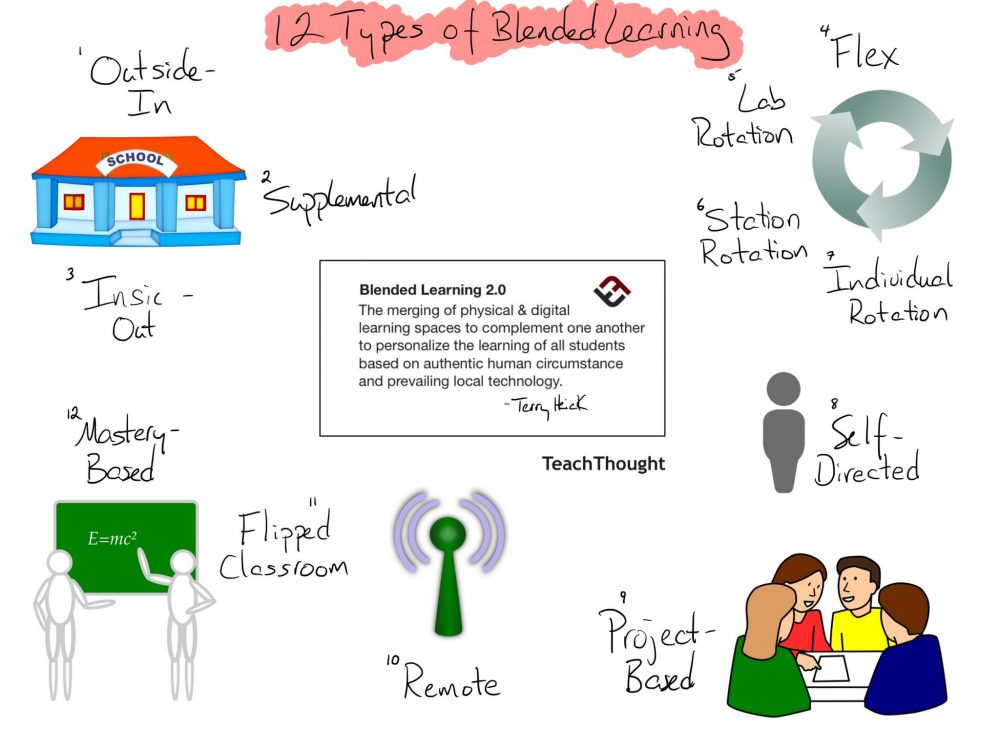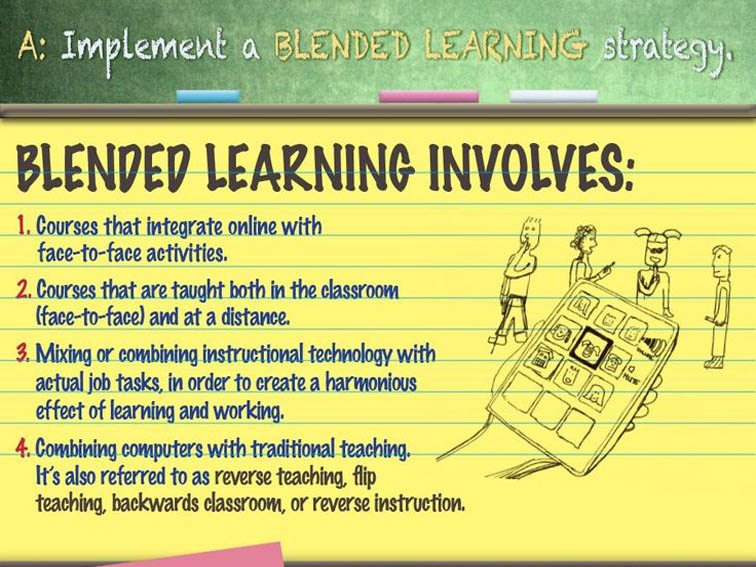
12 Of The Most Common Types Of Blended Learning
by TeachThought Staff
Blended Learning is not so much an innovation as it is a natural by-product of the digital domain creeping into physical spaces.
Broadly speaking, blended learning just means a mix of learning online and face-to-face, which means it’s likely your students are already doing some form of blended learning and have for years. As digital and social media become more and more prevalent in the life of learners, it was only a matter of time before learning became ‘blended’ by necessity.
Finding The Model That Works For Your School, Classroom, And Students
In The Definition Of Blended Learning, we offered that ‘blended learning is a model that combines online and face-to-face learning spaces and experiences.’ Below, we identify and describe 12 different types of blended learning.
Obviously, there aren’t just 12. It could be argued that there are thousands of types of blended learning varying by content, scale, technology, learning spaces, etc.
The purpose of this post is to A) Explain the most commonly referred to types of blended learning as most educators know them and B) Help you think more about blended learning as a flexible concept that ideally empowers both teachers and students to improve learning outcomes so that you can C) Identify and adapt a blended learning model that’s right for your school, classroom, and students.

6 Types Of Blended Learning You’ve Probably Heard Of
1. Station Rotation Blended Learning
Station-Rotation blended learning is a: “…model (that) allows students to rotate through stations on a fixed schedule, where at least one of the stations is an online learning station. This model is most common in elementary schools because teachers are already familiar with rotating in centers and stations.
Similar to: Lab Rotation Blended Learning
Primarily characterized by: the fixed schedule that guides the ‘blending’
2. Lab Rotation Blended Learning
‘The Lab Rotation’ model of blended learning, similar to “Station Rotation,’ works by “allow(ing) students to rotate through stations on a fixed schedule…in a dedicated computer lab allow(ing) for flexible scheduling arrangements with teachers…enabl(ing) schools to make use of existing computer labs.”
Similar to: Station Rotation Blended Learning
Primarily characterized by: the use school computer labs in new ways
3. Remote Blended Learning (also referred to as Enriched Virtual)
In Enriched Virtual blended learning, the student’s focus is on completing online coursework while only meeting with the teacher intermittently/as-needed.
This approach differs from the Flipped Classroom model in the balance of online to face-to-face instructional time. In an Enriched Virtual blended learning model, students wouldn’t see/work with/learning from a teacher on a daily basis face-to-face but would in a ‘flipped’ setting.
Similar to: A mix of Self-Directed, Flex Blended Learning, Flipped Classroom
Primarily characterized by: students completely coursework remotely and independently.
4. Flex Blended Learning
The ‘Flex’ is included in types of Blended Learning and its model is one in which… “a course or subject in which online learning is the backbone of student learning, even if it directs students to offline activities at times. Students move on an individually customized, fluid schedule among learning modalities. The teacher of record is on-site, and students learn mostly on the brick-and-mortar campus, except for any homework assignments. The teacher of record or other adults provide face-to-face support on a flexible and adaptive as-needed basis through activities such as small-group instruction, group projects, and individual tutoring.”
Similar to: Remote blended learning, Inside-Out Blended Learning
Primarily characterized by: its versatility to meet the needs of a variety of formal and informal learning processes (schools, organizations, homeschooling, etc.)
5. The ‘Flipped Classroom’ Blended Learning
Perhaps the most widely known version of blended learning, a ‘Flipped Classroom’ is one where students are introduced to content at home, and practice working through it at school supported by a teacher and/or peers. In this way, traditional roles for each space are ‘flipped.’
Similar to: Remote Blended Learning
Primarily characterized by: the retention of traditional learning forms in new contexts (i.e., studying at school and learning at home)
6. Individual Rotation Blended Learning
The Individual Rotation model allows students to rotate through stations, but on individual schedules set by a teacher or software algorithm. Unlike other rotation models, students do not necessarily rotate to every station; they rotate only to the activities scheduled on their playlists.”
Similar to: Mastery-Based Blended Learning
Primarily characterized by: the personalization of student learning as determined by individual schedules that have the chance to better meet the needs of each student
6 Types Of Blended Learning You Probably Haven’t Heard Of
7. Project-Based Blended Learning
Blended Project-Based Learning is a model in which the student uses both online learning—either in the form of courses or self-directed access—and face-to-face instruction and collaboration to design, iterate, and publish project-based learning assignments, products, and related artifacts.
Similar to: Self-Directed Blended Learning, Outside-In Blended Learning
Primarily characterized by: the use of online resources to support project-based learning
8. Self-Directed Blended Learning
In Self-Directed blended learning, students use a combination of online and face-to-face learning to guide their own personalized inquiry, achieve formal learning goals, connect with mentors physically and digitally, etc. As the learning is self-directed, the roles of ‘online learning’ and physical teachers change, and there are no formal online courses to complete.
In Self-Directed blended learning, one challenge for teachers is to be able to judge the and (somehow) success of the learning experience without de-authenticating it.
For students, the challenge is to seek out models of products, processes, and potential that can provide the kind of spark that can sustain learning while being self-aware enough to know what’s working and why, and to make adjustments accordingly. Some students need very little to soar, while others need support through very clear pathways that they can guide themselves through with autonomy and self-criticism.
Similar to: Inside-Out Blending Learning, Project-Based Blended Learning
Primarily characterized by: the exchange of traditional academic work for student-centered inquiry
9. Inside-Out Blended Learning
In Inside-Out blended learning, experiences are planned to ‘finish’ or ‘end up’ beyond the physical classroom, but still require and benefit from the unique advantages of both physical and digital spaces.
In both the Outside-In and Inside-Out models, the nature of the ‘online learning’ is less critical than the focus on platforms, spaces, people, and opportunity beyond the school walls. (The ‘online’ components could be self-directed inquiry and/or formal eLearning courses and curriculum.)
Because the learning pattern is ‘outward,’ Project-Based blended learning is an excellent example of the Inside-Out learning model.
As with Outside-In blended learning, there is a need for expert guidance, learning feedback, content teaching, and psychological and moral support from face-to-face interactions on a daily basis.
Well-designed, each of the three ‘areas’ plays to its strengths and complements the other two.
Similar to: Outside-In blended learning, Blended Project-Based Learning
Primarily characterized by: student movement between digital and physical spaces
10. Outside-In Blended Learning
In Outside-In blended learning, experiences are planned to ‘start’ in the non-academic physical and digital environments students use on a daily basis, but finish inside a classroom.
This could mean traditional letter grades and assessment forms, or less traditional teaching and learning that simply uses the classroom as a ‘closed-circuit’ publishing ‘platform’—a safe space to share, be creative, collaborate, and give and receive feedback that grows student work.
Well-designed, each of the three ‘areas’ plays to its strengths and complements the other two. While the pattern is Outside-In, unlike Remote blended learning there is still a need for guidance, teaching, and support from face-to-face interactions on a daily basis.
Similar to: Inside-Out Blended Learning
Primarily characterized by: student movement between digital and physical spaces; the potential authenticity of student work
11. Supplemental Blended Learning
In this model, students complete either entirely online work to supplement their day-to-day face-to-face learning, or entirely face-to-face learning experiences to supplement the learning gained in online courses and activities.
The big idea here is supplementing—critical learning objectives are met entirely in one space while the ‘opposite’ space provides the student with specific supplementing experiences that the other did not or could not provide.
12. Mastery-Based Blended Learning
Students rotate between online and face-to-face learning (activities, assessments, projects, etc.) based on the completion of mastery-based learning objectives.
Assessment design is crucial in any mastery-based learning experience; the ability to use face-to-face and digital assessment tools is either powerful or ‘complicated’ depending on the mindset of the learning designer.
*Sources include TeachThought, the Christensen Institute and blendedlearning.org